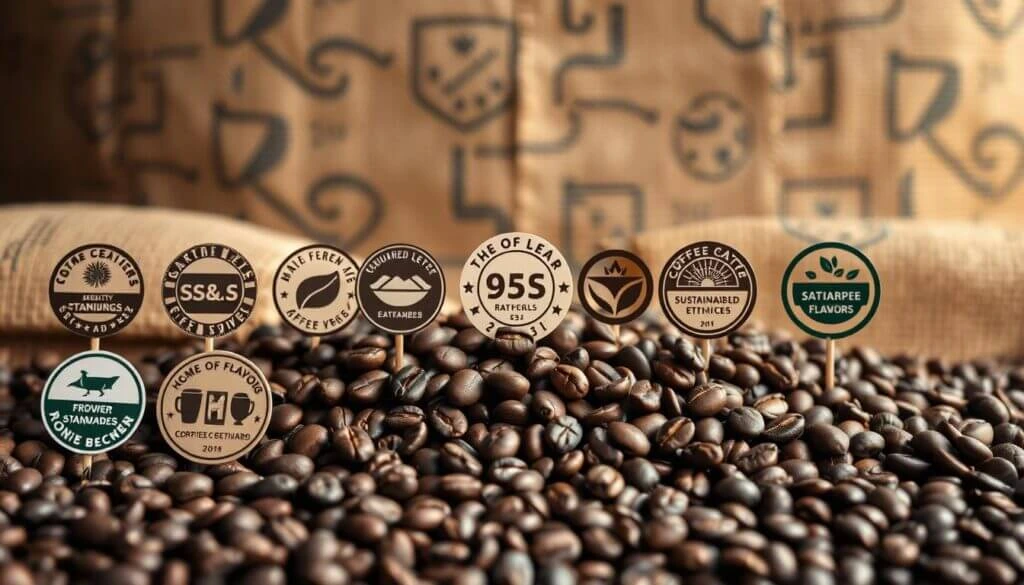What makes the perfect cup of coffee? Is it the type of coffee beans, the roast level, or the brewing method? With many types of coffee beans out there, like Arabica and Robusta, finding the right one can be tough. Exploring specialty coffee beans can make your coffee experience better. Whether you want a smooth flavor or something bold, knowing about coffee beans is key.

Table of Contents
Key Takeaways
- Arabica coffee-beans account for approximately 60-70% of global coffee production, while Robusta beans make up about 30-40%.
- The flavor profile of coffee can vary significantly based on the growing location, with African beans often exhibiting fruity and floral notes.
- Light roasted coffee generally has a higher acidity level than dark roasted coffee, with light roasts having a sharp acidity and dark roasts being less acidic.
- Coffee brewing methods can influence the flavor and quality of coffee, with recommendations suggesting dark roasts for cold brew and medium roasts for pour-over brewing.
- Whole bean coffee retains freshness longer than pre-ground coffee, making it preferable for quality-conscious consumers who seek the best coffee beans.
- Specialty coffee beans can offer a more complex and nuanced flavor profile compared to commercial coffee beans.
- Understanding the different types of coffee beans, including Arabica and Robusta, is critical to finding the best coffee beans for your taste preferences.
Understanding Different Types of Coffee-Beans
Exploring coffee reveals many types of beans, each with its own taste and traits. Arabica coffee beans make up 60-70% of the world’s coffee, known for their mild taste. Robusta coffee beans, on the other hand, are bold and rich, with more caffeine.
Coffee blends often mix 3 parts arabica coffee beans with 1 part robusta coffee beans. This blend can cut costs by up to 20%. For a unique taste, try specialty coffee beans like Liberica and Excelsa. Liberica has fruity and floral notes, while Excelsa is tart and fruity.
- Arabica coffee beans grow mainly in high places, with Brazil leading exports.
- Robusta coffee beans are mostly grown in Africa and Indonesia.
- Specialty coffee beans, like Liberica and Excelsa, are prized for their distinct flavors.
Knowing about coffee beans helps you choose the best coffee for your taste. Whether you like the soft taste of arabica coffee beans or the strong taste of robusta coffee beans, there’s a lot to discover.
The Journey from Bean to Cup
Exploring coffee means learning about its journey from bean to cup. This path includes steps like harvesting, coffee bean processing, coffee roasting, and coffee brewing. Each step is key to the coffee’s taste and quality. About 125 million people worldwide rely on coffee for their jobs, with 80% coming from smallholder farmers.
Harvesting starts between October and December. There are two main ways to pick coffee: strip picking and selective picking. Strip picking takes all cherries, while selective picking picks only ripe ones. This is better for the Arabica variety.
After picking, the cherries go through wet or dry processing. This can take days to weeks.
Here’s a quick look at coffee production:
- Harvesting: Removing coffee cherries from the tree
- Coffee bean processing: Removing the cherry flesh and drying the beans
- Coffee roasting: Transforming the green coffee beans into the flavorful beans you brew
- Coffee brewing: Extracting the flavors from the roasted coffee beans
The roasting process changes the beans’ chemistry. It turns starches into sugars and brings out flavors. Beans can age from 6 months to 3 years to enhance taste. The last step is brewing, where the beans are ground and made into your favorite coffee.
Exploring Coffee Bean Origins
Coffee beans grow in many places worldwide, each with its own climate, soil, and culture. As you dive into coffee, you’ll find that ethiopian coffee beans and colombian coffee beans stand out. Knowing where they come from helps you enjoy their unique tastes.
Countries near the equator are perfect for growing coffee. Brazil leads in coffee exports, with about 37% of Arabica coffee. Ethiopia and Colombia are also famous for their top-notch Arabica beans.
- Altitude: Arabica coffee grows best at 3,600 to 6,300 feet.
- Soil: The soil’s type and nutrients affect the coffee’s flavor.
- Climate: Mild temperatures and clear wet and dry seasons make great coffee.
Knowing about coffee bean origins and flavor factors helps you choose. Whether you like the bright taste of ethiopian coffee beans or the balanced taste of colombian coffee beans, there’s much to discover.
Roast Levels and Their Impact
Coffee roast levels greatly affect the taste and quality of coffee beans. There are light roast, medium roast, and dark roast levels, each with its own taste and characteristics.
The roast level is set by the roasting temperature and time. Coffee roast levels range from a light roast with a cinnamon color to a dark roast that’s almost black. The “First Crack” happens at 380-400℉, starting the browning. The “Second Crack” at 430-450℉ marks the shift to dark roast.
Here’s a quick look at the coffee roast levels:
- Light roast: has a cinnamon color and tastes fruity and floral.
- Medium roast: known as American or City, it’s often called “breakfast” coffee. It tastes like caramel, toasted nuts, and milk chocolate.
- Dark roast: has bittersweet chocolate and drier nut flavors, with less fruity or floral notes.

In summary, knowing about the coffee roast levels and their impact on taste and quality helps in choosing coffee beans. Whether you like a light roast, medium roast, or dark roast, the roast level changes the taste of your coffee.
Decoding Coffee Bean Processing Methods
Coffee bean processing methods greatly affect the taste and quality of coffee. As you dive into the coffee world, you’ll find many processing methods. Each has its own special traits. The main types are fully washed, honey, and natural, each changing the coffee’s flavor.
The method used in coffee bean processing really matters. Washed processing has a short fermentation time, leading to a clean, bright taste. Natural processing, on the other hand, takes weeks to dry. It makes a rich, full-bodied coffee with fruity notes.
- Washed processing: clean, bright, and crisply acidic profile
- Natural processing: velvety, full-bodied cup with berry-like or fruity notes
- Honey processing: harmonious blend of fruity and nutty flavors
Knowing about coffee bean processing methods opens up a world of flavors. Whether you like the sharp taste of washed processing or the fruity notes of natural processing, there’s much to discover in coffee.
Understanding Coffee Bean Certifications
Exploring coffee, you’ll find certifications that ensure beans are made and traded fairly. Fair trade and organic are two key ones. Fair trade means farmers get a set price that covers costs and ensures a good life. They also get extra money for community projects.
Certifications like organic and fair trade really help farmers and the planet. Organic coffee can earn more, helping farmers invest in better farming. Bird Friendly Coffee, for example, supports trees and birds, and requires organic farming.
Some important certifications include:
- Fair Trade: ensures fair prices and working conditions for farmers
- Organic: prohibits the use of synthetic pesticides and fertilizers
- Rainforest Alliance: focuses on environmental and social sustainability in agriculture
- Bird Friendly Coffee: requires shade cover and organic farming practices

When picking coffee, think about what matters to you. Supporting certified coffee helps the industry be better for everyone. Fair trade and organic make a big difference for farmers and the environment.
| Certification | Description | Benefits |
|---|---|---|
| Fair Trade | Ensures fair prices and working conditions for farmers | Improves economic conditions for farmers, promotes sustainable production |
| Organic | Prohibits the use of synthetic pesticides and fertilizers | Promotes environmental sustainability, improves soil health |
| Rainforest Alliance | Focuses on environmental and social sustainability in agriculture | Promotes biodiversity, improves working conditions for farmers |
How to Select Coffee Beans for Different Brewing Methods
Choosing coffee beans is key, and the brewing method matters a lot. Each method needs specific beans to get the best taste. Knowing which beans work best for each method helps you pick wisely.
Methods like espresso, pour-over, and French press need different grinds. Espresso wants a fine grind, while pour-over and French press prefer medium-coarse and coarse grinds. The taste of the coffee also guides your choice, with lighter tastes good for pour-over and richer tastes better for French press or espresso.
Some espresso favorites, like Big Trouble and Hologram, have consistent tastes all year. For pour-over, use a finer grind for small cones and a medium-coarse grind for larger ones. French press needs a coarse grind. The right grind and bean type greatly affect the taste and quality of your coffee.
Here are some key considerations for selecting coffee beans for different brewing methods:
- Espresso: very fine grind, high caffeine content, and a bold flavor profile
- Pour-over: medium-coarse grind, lighter flavors, and a balanced acidity
- French press: coarse grind, heavier flavors, and a rich, full-bodied texture
By knowing what each brewing method needs and choosing the right beans, you can make your coffee experience better. Enjoy a perfectly brewed cup every time.
Storage and Freshness Guidelines
To keep your coffee beans fresh, proper coffee bean storage is key. Many things can affect coffee freshness, like air, light, moisture, and heat. It’s important to store them in a cool, dry spot to keep their taste and smell.
Here are some tips for keeping your coffee fresh:
- Store coffee beans in an airtight container to stop oxygen from getting in and causing them to stale.
- Keep coffee beans away from direct sunlight and heat sources.
- Use coffee beans within a few weeks of opening for the best taste and smell.
- Freezing coffee beans can slow down staling, but use airtight packaging to avoid odors.
Whole coffee beans stay fresh longer than ground coffee because they have less surface area exposed to air. Using the oldest beans first helps keep your coffee fresh. By following these tips, you can enjoy your coffee’s best flavor and aroma.
Proper storage can make coffee beans and grounds stay fresh longer. Using a container with an airtight seal or a vacuum system helps keep coffee quality up. Coffee beans don’t spoil, but they lose their aroma and taste over time. So, it’s vital to store them right to keep them fresh.
Specialty vs Commercial Coffee Beans
Choosing the right coffee beans can be tricky. You’ll find two main types: specialty and commercial. Specialty beans are known for their high quality and unique flavors. Commercial beans, on the other hand, are mass-produced and might not have the same taste.
The quality of coffee beans depends on several factors. These include the bean’s origin, how it’s processed, and its roast level. Specialty beans are usually 100% Arabica, known for their rich flavors and lower bitterness. Commercial beans might be a mix of Arabica and Robusta, leading to a less desirable taste.
Price Considerations
Specialty coffee beans are pricier than commercial ones. This is because they’re harvested and processed with more care. They’re hand-picked, ensuring better quality. Commercial beans, picked by machines, are cheaper but might not taste as good.
Quality Indicators
Quality in coffee beans is measured by several factors. These include the bean’s origin, processing method, and roast level. Specialty beans are graded on a 100-point scale, with scores above 80 considered top-notch. Commercial beans usually score below 75.
When deciding between specialty and commercial beans, think about what you value most. If you want a unique taste, go for specialty beans. But if you’re watching your budget, commercial beans might be more affordable. It all comes down to your personal taste and budget.
Specialty coffee beans have health benefits too. They’re full of antioxidants and vitamins. They also have lower acidity, making them easier on sensitive stomachs. Whether you’re a coffee lover or just want a great cup, specialty beans are worth trying.
Where to Buy Quality Coffee Beans
There are many places to buy quality coffee beans. You can go to local roasters, shop online, or try subscription services. Each choice has its own good and bad points to think about.
Buying from local roasters helps local businesses and gives you fresh beans. You can also get advice on the coffee’s origin and roast level.
Benefits of Local Roasters
- Freshly roasted beans
- Support for local businesses
- Personalized recommendations
On the other hand, online retailers have a big selection of coffee beans. You can read reviews, compare prices, and have your coffee delivered.

Benefits of Online Retailers
- Wide selection of coffee beans
- Convenient delivery options
- Competitive prices
Subscription services let you get new coffee beans every month. It’s a great way to try different coffees and find new favorites.
Benefits of Subscription Services
- Discover new coffee beans every month
- Convenient and hassle-free
- Opportunity to try different roast levels and origins
The best choice for you depends on what you like and need. Whether it’s local roasters, online shops, or subscription services, do your homework. Read reviews to make sure you’re getting top-notch coffee beans.
Common Coffee Bean Myths Debunked
Exploring coffee can lead to myths that might confuse you. It’s key to know the truth to fully enjoy your coffee. A common myth is that dark-roasted coffee has more caffeine than light roasts. But, coffee facts reveal that caffeine goes down as roasting time goes up. So, darker beans have less caffeine than lighter ones.
Another myth is that coffee can sober up someone who’s drunk. But, caffeine just wakes you up, it doesn’t undo alcohol’s effects. Also, coffee is mostly water, helping with your daily hydration. Storing coffee in the fridge is a bad idea because it loses its flavor and smell.
Here are some important coffee bean myths and facts to remember:
- Decaffeinated coffee must have at least 97% of its caffeine removed, leaving approximately 7mg of caffeine per 8-ounce cup.
- Dark roast coffee contains slightly less caffeine than lighter roasts due to moisture loss during roasting.
- The safe adult caffeine consumption limit is 400mg per day.
Knowing these coffee facts and debunking coffee bean myths helps you make better choices. You’ll appreciate the rich world of coffee more.
Conclusion: Choosing Your Perfect Coffee Bean
Choosing the perfect coffee bean is a personal journey. It requires an open mind and a willingness to try new things. You’ve learned that there’s a wide variety of coffee beans to explore.
Whether you like the bright, fruity notes of Ethiopian Yirgacheffe or the rich, chocolatey tones of Brazilian Fazenda, the key is to find what you like. Your taste preferences and brewing methods should guide your choice.
As you continue to explore, remember to focus on freshness and quality over price. Buy freshly roasted beans from local roasters or online. Don’t be afraid to try new origins and processing techniques.
By embracing the journey of finding your perfect coffee bean, you’ll not only improve your daily coffee. You’ll also gain a deeper appreciation for the art of coffee.

FAQ
What are the different types of coffee beans?
Coffee beans come in two main types: Arabica and Robusta. Arabica is seen as higher quality and more flavorful. Other varieties include Kona, Jamaica Blue Mountain, and Geisha.
What are the characteristics of Arabica and Robusta coffee beans?
Arabica beans have a smooth, balanced flavor with notes of sweetness and acidity. Robusta beans are more bitter, have strong caffeine, and are often used in espresso blends.
How does the coffee production process impact the final flavor?
The journey from bean to cup is complex. It includes harvesting, processing, roasting, and brewing. Each step affects the coffee’s flavor and quality.
What are the different coffee-growing regions and how do they affect the beans?
Coffee grows in many regions worldwide, each with its own climate and soil. For example, Ethiopian beans are fruity, while Colombian beans are smooth.
How do roast levels impact the flavor of coffee beans?
Roast levels change the flavor and aroma of coffee beans. Light roasts are acidic and bright, while dark roasts are bolder and smoother.
What are the different coffee bean processing methods and how do they affect the final product?
Beans can be processed in ways like washed, natural, and honey. These methods can change the flavor, acidity, and body of the coffee.
What are the different coffee bean certifications and why are they important?
Certifications like organic and fair trade ensure beans are sustainably and fairly produced. They guarantee quality and ethics in coffee production.
How do I select the right coffee beans for different brewing methods?
The right bean can greatly affect your coffee’s taste, depending on how you brew it. For example, espresso needs a dark roast blend, while pour-over works well with lighter roasts.
How should I store and handle coffee beans to maintain freshness and quality?
Keeping beans fresh and quality involves proper storage. Store them in an airtight container, away from heat, light, and moisture. This preserves their flavor and aroma.
What is the difference between specialty and commercial coffee beans?
Specialty beans are of higher quality, focusing on unique flavors and sustainable sourcing. Commercial beans are often used in blends and may prioritize cost over quality.
Where can I buy quality coffee beans?
You can buy quality beans from local roasters, online, or through subscription services. Each option has its own benefits and drawbacks in terms of selection, price, and convenience.
What are some common myths about coffee beans?
Many myths surround coffee beans, like dark roasts having more caffeine or all beans being the same. Debunking these myths helps you make better coffee choices.
Source Links
- Guide to Your Perfect Coffee Beans | Stone Street Coffee
- The best coffee beans to buy online, tried and tested
- How to Choose Coffee Beans: A Beginner’s Guide
- Types of Coffee Beans and What Sets Them Apart
- Types Of Coffee Beans: Their Similarities and Differences
- Journey of the coffee bean: from seed to cup in 9 steps
- The Journey of the Coffee Bean From Plant to Cup
- Exploring Different Types Of Coffee Beans
- Exploring Types of Coffee Beans And How To Choose Them
- An Intro to Coffee Roasts
- A Simplified Guide To Roast Level | Trade Coffee
- Roast Levels: A Primer
- How to Read a Coffee Label
- From Bean to Brew: Coffee Processing Methods Demystified
- Coffee Certifications 101: Organic, Bird Friendly, Fair Trade, And Bey – JavaPresse Coffee Company
- What Type Of Coffee Certifications Exist – A Short Guide
- Coffee Basics: Brewing Methods
- How to Choose Coffee Beans: A Beginners Guide
- 4 Types of Coffee Beans: How to Choose | KitchenAid
- The Shelf Life of Coffee Beans: A Comprehensive Guide
- Please, Don’t Store Your Coffee Beans in the Fridge
- Coffee Storage: What is the Best Storage for Coffee?
- Savor the Difference: Specialty Coffee vs. Commercial Brews
- Specialty coffee VS commercial coffee: what’s the difference?
- Specialty Coffee vs Commercial Coffee: A Discerning Drinker’s Guide
- Buy Whole Coffee Beans Online – Verena Street Coffee
- Coffee
- Stop Buying Subpar Coffee from the Grocery Store — These Are 9 Better Places to Buy It Online
- 7 Myths and Misconceptions About Coffee
- The 5 Most Common Coffee Myths, Debunked
- Myth of Fact? 1 Common Coffee Myths Debunked
- The 4 Types of Coffee Beans You Must Know for the Best Coffee Experience
- The Ultimate Guide to Choosing the Perfect Coffee Bean: Understanding Flavors, Roasting, and Price
- Coffee Buying Guide: Choosing the Best Coffee Beans
- Ultimate Guide to Different Types of Coffee
- The Best Decaf Coffee Guide: Your No-Caffeine Solution
- How to Make Breve Coffee at Home: Easy Recipe Guide 2025
- How to Choose the Best Coffee Maker for Your Needs











One Comment